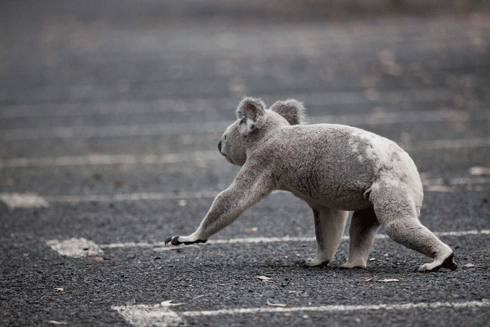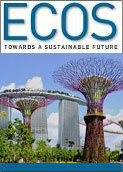
|
Published: 18 March 2013
Could ‘mining magnate thinking’ help conserve koalas?
Koalas in south-east Queensland are in trouble. They are threatened by vehicles, dog attacks and disease. And these threats are growing as koala habitat is cleared to make way for housing and industrial estates. How much more information do we need about these koalas before we can take action? Sean Maxwell puts on his business-thinking hat and arrives at a surprising answer.
The rate of decline of koala populations in south-east Queensland is alarming, with the population crashing from an estimated 6000 individuals to fewer than 2000 in the space of 15 years.
In response to appeals from koala managers, conservation scientists and the public to do something, the Queensland Government has allocated $26.5 million to managing koalas in south-east Queensland over the next four years.
How should we spend this $26.5 million to maximise the chance of koalas persisting in South-East Queensland?
Most natural resource management budgets are typically allocated to either gaining new information about the species (or ecosystem) in question or to direct management action. In the case of the koala, there is uncertainty about the birth and death rates, and the effect of forest cover on these rates. Gaining new information that would reduce these uncertainties may lead to more effective management strategies.
Alternatively, new information about these uncertainties may not change how we are currently managing the species, and a better investment could be to allocate funds to direct management action now.
These kinds of resource allocation problems are not restricted to natural resource management. They are common in health, economics, business management and the mining sector. Decision-makers in these fields have turned to analytical tools to help make good resource allocation decisions in the face of uncertainty.
For example, imagine that you are a business risk manager for Clive Palmer or Gina Rinehart and that you’re reviewing a proposal for a potentially lucrative coal mining project. The project could bring in big returns, but the mining sector is competitive, and you don’t want to blow millions on a project that isn’t viable.
If you were in this position, the question you would ask yourself is: ’should I fund geological studies, exploratory drilling and price forecasts to reduce my level of uncertainty about the site, and hopefully improve the long-term success of the proposed mining project?’
Instead of relying on gut feelings or expert opinion to answer this question, the smart approach is to use ‘value-of-information’ analysis to help make this decision.1 It presents a way of evaluating the benefits of collecting additional information before making a decision.
If after conducting the value-of-information analysis you see that the expected improvement in your profit margin from having additional information is not worth the cost of obtaining that information, then there’s little point in making that investment.
Where a mining company might think in terms of profit, environmental decision-makers think in terms of conservation outcomes. Given limited funds to address the enormous challenge of arresting the decline in koala numbers, should we invest in learning more or just get on with the job?
Over the past year, I have been working with Environmental Decisions Group (EDG) researchers Eve McDonald-Madden, Jonathan Rhodes and Hugh Possingham in applying value-of-information analysis to evaluate the benefits of resolving uncertainty surrounding the declining koala population in South-East Queensland.
We modelled the effectiveness of koala management using current levels of information and compared this to a situation where all uncertainty about birth and death rates, and the effect of forest cover on these rates, was resolved.
We found the optimal management strategies with and without new information on birth and death rates, and the effect of forest cover on these rates, to be very similar. This finding suggests that resolving uncertainty will have negligible effects on management performance. Indeed, we found that a 0.034 per cent improvement in the population growth rate is the best we could expect if uncertainty was resolved.
When we converted values of information, in terms of population growth rate, into values of information in terms of dollars, we found that if resolving uncertainty costs more than 1.7 per cent of the koala management budget, it would be more cost-effective to allocate that money to direct management action now.
In the coming months, we intend to explore the value of resolving other sources of uncertainty surrounding the management of koalas in South-East Queensland.
This future research may place more value on gaining new information, but the results of our analysis to date suggest that allocating resources to direct management action now will likely provide better returns on investment than gaining new information.
The low values of information illustrated in our koala case study have also been mirrored in case studies using other focal species. However, cases exist where gaining additional information has dramatically improved management performance.
These contrasting results from different value-of-information analyses show how uncertainty can have variable effects on our ability to achieve a management objective. They highlight the benefits and importance of a value-of-information analysis before making that all important investment decision.
Sean Maxwell is an Honours student at the University of Queensland whose work is being supervised by Dr Eve McDonald-Madden, Dr Jonathon Rhodes and Professor Hugh Possingham. The EDG is a network of conservation researchers from Australian and overseas institutions – including CSIRO – working on the science of effective decision making to better conserve biodiversity. This article is republished with permission from EDG’s monthly magazine, Decision Point.
|
Previous work by EDG researchers led by Jonathan Rhodes showed that, as forest cover is lost, total koala mortality and the proportion of that mortality arising from ‘road kills’ is increasing. |

Koala declines are linked to many increasing and emerging threats – running the risk of car accidents more often is one piece of the jigsaw. Credit: Liana Joseph
|
But restoring habitat on its own would be insufficient to prevent further population declines. Using integrated population modelling to understand the implications of multiple threats to koalas in South-East Queensland, the research highlighted that management needed to address the multiple threats of habitat loss, disease, vehicle collisions, dog attacks and climate change together. |
1 [EDITOR] The entry in wikipedia on ‘value-of-information’ analysis cites this simple example to illustrate the concept: Consider the situation of deciding on a 'vacation activity' with one uncertainty – what will the 'weather condition' be? The dilemma is that we will only know the 'weather condition' after we have decided and begun the 'vacation activity'.
The value of perfect information on’ weather condition’ captures the value of being able to know ‘weather condition’ even before making the ‘vacation activity’ decision. It is quantified as the highest price the decision-maker is willing to pay for being able to know ‘weather condition’ before making the ‘vacation activity’ decision.




